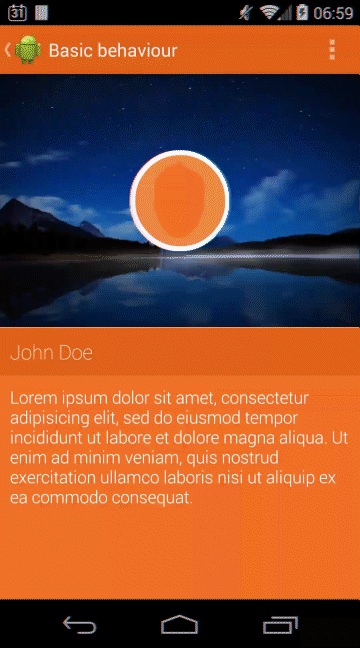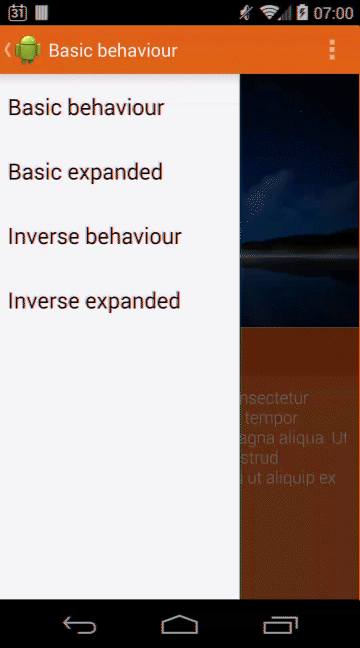ExpandablePanel alternatives and similar packages
Based on the "Other Widget" category.
Alternatively, view ExpandablePanel alternatives based on common mentions on social networks and blogs.
-
AndroidSlidingUpPanel
This library provides a simple way to add a draggable sliding up panel (popularized by Google Music and Google Maps) to your Android application. Brought to you by Umano. -
BottomBar
(Deprecated) A custom view component that mimics the new Material Design Bottom Navigation pattern. -
ShortcutBadger
An Android library supports badge notification like iOS in Samsung, LG, Sony and HTC launchers. -
SystemBarTint
[DEPRECATED] Apply background tinting to the Android system UI when using KitKat translucent modes -
TapTargetView
An implementation of tap targets from the Material Design guidelines for feature discovery. -
android-viewbadger
[DEPRECATED] A simple way to "badge" any given Android view at runtime without having to cater for it in layout -
android-stackblur
Android StackBlur is a library that can perform a blurry effect on a Bitmap based on a gradient or radius, and return the result. The library is based on the code of Mario Klingemann. -
android-iconify
Android integration of multiple icon providers such as FontAwesome, Entypo, Typicons,... -
DraggablePanel
DISCONTINUED. Android library used to create an awesome Android UI based on a draggable element similar to the last YouTube graphic component. -
aFileChooser
DISCONTINUED. [DEPRECATED] Android library that provides a file explorer to let users select files on external storage. -
Swipecards
A Tinder-like Android library to create the swipe cards effect. You can swipe left or right to like or dislike the content. -
TourGuide
TourGuide is an Android library that aims to provide an easy way to add pointers with animations over a desired Android View -
StickyGridHeaders
DISCONTINUED. An Android Library that makes it easy to make grid views with sectioned data and headers that stick to the top. -
FloatingView
FloatingView can make the target view floating above the anchor view with cool animation -
TileView
TileView is a subclass of android.view.ViewGroup that asynchronously displays, pans and zooms tile-based images. Plugins are available for features like markers, hotspots, and path drawing. -
Bubbles for Android
Bubbles for Android is an Android library to provide chat heads capabilities on your apps. With a fast way to integrate with your development. -
RippleView
View that imitates Ripple Effect on click which was introduced in Android L (for Android 2.3+) -
Android-ActionItemBadge
This library offers a simple method to add a small badge icon to your ActionBar-MenuItem -
android-sliding-layer-lib
DISCONTINUED. Highly customizable SlidingLayer as you have seen in Wunderlist -
SortableTableView
An Android library containing a simple TableView and an advanced SortableTableView providing a lot of customisation possibilities to fit all needs. -
ScratchView
ScratchView repo is UX Design involving scratch cards like views which are scratched to reveal the information they conceal. -
FabricView
A new canvas drawing library for Android. Aims to be the Fabric.js for Android. Supports text, images, and hand/stylus drawing input. The library has a website and API docs, check it out
WorkOS - The modern identity platform for B2B SaaS

* Code Quality Rankings and insights are calculated and provided by Lumnify.
They vary from L1 to L5 with "L5" being the highest.
Do you think we are missing an alternative of ExpandablePanel or a related project?
README
Expandable Panel Android Library




Check ExpandablePanel Demo application on GooglePlay:
Details
This Android library implements the expand by sliding logic for a top or a bottom view in a two children view composition. That's the default behaviour, but it allows you to set a different View as the expandable one, making this component support multiple views inside it.
It supports Android SDK 2.1 (Eclair) as minimum.
ExpandablePanel library brings a custom view class called ExpandablePanelView to the final user. It implements the needed logic for integrating the expandable logic into your own Android application.
Custom Attributes
ExpandablePanel lib allows you to customize the following properties. Feel free to combine them to create cool user interfaces:
expandablepanel:completionPercent: % of the parent's height where you want the autocomplete animation to begin working.expandablepanel:completeExpandAnimationSpeed: Speed for the autocomplete animation.expandablepanel:completeShrinkAnimationSpeed: Speed for the autoshrink animation.expandablepanel:beginExpanded: Use it if you need the topView to begin expanded. If that's your case, the view will play a bounce animation at start to inform the user about the hidden bottom view.expandablepanel:bounceCount: Use it to set the number of times topView is going to play bounce animation when it begins expanded.expandablepanel:invertBehavior: Use it to invert the panel's behaviour and make bottomView become the expandable one. You can combine it with any other custom attributes. Bounce animation will get inverted too when using this attr.expandablepanel:animableViewId: Use it to assign an animable view using the view identifier if yourExpandablePanelViewcontains more than 2 child. This attribute is not mandatory, if you don't use it, first or second child (based on theexpandablepanel:invertBehaviorattribute) is going to be used as the animable view.expandablepanel:autoAnimateOnClick: Use this one to enable automatic expanding or shrinking when user clicks on animable view.
Usage
In order to make it work, you will need to use ExpandablePanelView class into your Android XML Layout.
- 1. Add
ExpandablePanelViewto the layout. - 2. Add two children views to the ExpandablePanelView XML element.
- 3.
ExpandablePanelViewextendsRelativeLayout, so you will need to give an android id to the top view and setup theandroid:belowattribute in the bottom one. - 4. Set the
xmlns:draggable_view="http://schemas.android.com/apk/res-auto"if you are going to use any of the cusom attributes.
Use ExpandableListener if you want your class to be able to get expandable callbacks. Following methods are offered to the user:
onExpandingStarted: Dispatched when the user starts expanding the view.onExpandingFinished: Dispatched when autocomplete expanding animation is finished.onShrinkStarted: Dispatched when the user starts shrinking the view.onShrinkFinished: Dispatched when autocomplete shrinking animation is finished.onExpandingTouchEvent: Dispatched meanwhile the user is dragging to expand or shrink the view. This one is very useful if you want to map touch coordinates to your class and be able to use them for creating cool combined animations.
Basic Usage
<RelativeLayout xmlns:android="http://schemas.android.com/apk/res/android"
xmlns:tools="http://schemas.android.com/tools"
xmlns:expandablepanel="http://schemas.android.com/apk/res-auto"
android:layout_width="match_parent"
android:layout_height="match_parent"
tools:context=".MainActivity">
<com.jorgecastilloprz.expandablepanel.ExpandablePanelView
android:layout_width="match_parent"
android:layout_height="match_parent"
android:background="@android:color/darker_gray"
expandablepanel:completionPercent="0.8"
expandablepanel:completeExpandAnimationSpeed="150"
expandablepanel:completeShrinkAnimationSpeed="200">
<ImageView
android:id="@+id/topLayout"
android:layout_width="match_parent"
android:layout_height="250dp"
android:src="@drawable/nightbackground"
android:scaleType="centerCrop"/>
<ImageView
android:background="@color/material_pink"
android:layout_width="match_parent"
android:layout_height="match_parent"
android:layout_below="@+id/topLayout"/>
</com.jorgecastilloprz.expandablepanel.ExpandablePanelView>
</RelativeLayout>
Begin Expanded Usage:
<com.jorgecastilloprz.expandablepanel.ExpandablePanelView
android:id="@+id/expandablePanelView"
android:layout_width="match_parent"
android:layout_height="match_parent"
android:background="@android:color/darker_gray"
expandablepanel:completionPercent="0.8"
expandablepanel:completeExpandAnimationSpeed="150"
expandablepanel:completeShrinkAnimationSpeed="200"
expandablepanel:beginExpanded="true"
expandablepanel:bounceCount="2">
<ImageView
android:id="@+id/topLayout"
android:layout_width="match_parent"
android:layout_height="250dp"
android:src="@drawable/nightbackground"
android:scaleType="centerCrop"/>
<ImageView
android:background="@color/material_pink"
android:layout_width="match_parent"
android:layout_height="match_parent"
android:layout_below="@+id/topLayout"/>
</com.jorgecastilloprz.expandablepanel.ExpandablePanelView>
Invert Behaviour Usage:
- You will need to remove
android:layout_belowfrom bottomView and addandroid:layout_aboveto the top one, in order to make Android capable of settingfixed bottomView heightbefore topViewmatch_parentheight. - You must set
android:layout_alignParentBottom="true"in bottom view too.
<RelativeLayout xmlns:android="http://schemas.android.com/apk/res/android"
xmlns:tools="http://schemas.android.com/tools"
xmlns:expandablepanel="http://schemas.android.com/apk/res-auto"
android:layout_width="match_parent"
android:layout_height="match_parent"
tools:context=".MainActivity">
<com.jorgecastilloprz.expandablepanel.ExpandablePanelView
android:id="@+id/expandablePanelView"
android:layout_width="match_parent"
android:layout_height="match_parent"
android:background="@android:color/darker_gray"
expandablepanel:completionPercent="0.8"
expandablepanel:completeExpandAnimationSpeed="150"
expandablepanel:completeShrinkAnimationSpeed="200"
expandablepanel:invertBehavior="true">
<RelativeLayout
android:id="@+id/topLayout"
android:layout_width="match_parent"
android:layout_height="match_parent"
android:layout_above="@+id/bottomLayout">
<LinearLayout
android:layout_width="match_parent"
android:layout_height="match_parent"
android:orientation="vertical"
android:weightSum="100">
<ImageView
android:layout_width="match_parent"
android:layout_height="0dp"
android:layout_weight="99"
android:src="@drawable/nightbackground"
android:scaleType="centerCrop"/>
<View
android:layout_width="match_parent"
android:layout_height="0dp"
android:layout_weight="1"
android:background="@color/flat_orange_bright" />
</LinearLayout>
<expandablepanel.jorgecastilloprz.com.expandablepanel.ui.components.CircledImageView
android:id="@+id/avatar"
android:layout_width="100dp"
android:layout_height="100dp"
android:src="@drawable/avatar"
android:layout_centerInParent="true"/>
</RelativeLayout>
<ImageView
android:id="@+id/bottomLayout"
android:layout_width="match_parent"
android:layout_height="300dp"
android:src="@drawable/daybackground"
android:scaleType="centerCrop"
android:layout_alignParentBottom="true"/>
</com.jorgecastilloprz.expandablepanel.ExpandablePanelView>
</RelativeLayout>
Import ExpandablePanel dependency
Add the next code to your build.gradle project dependencies:
dependencies {
compile 'com.github.jorgecastilloprz:expandablepanel:1.0.4@aar'
}
Set the mavenCentral repo into the external build.gradle:
buildscript {
repositories {
mavenCentral()
}
dependencies {
classpath 'com.android.tools.build:gradle:0.12.+'
}
}
allprojects {
repositories {
mavenCentral()
}
}
If you are using Maven, use the following code:
<dependency>
<groupId>com.github.jorgecastilloprz</groupId>
<artifactId>expandablepanel</artifactId>
<version>1.0.4</version>
<type>aar</type>
</dependency>
Developer
- Jorge Castillo Pérez [email protected]
- Twitter acc - @JorgeCastilloPr (https://twitter.com/jorgecastillopr)
License
Copyright 2014 Jorge Castillo Pérez
Licensed under the Apache License, Version 2.0 (the "License");
you may not use this file except in compliance with the License.
You may obtain a copy of the License at
http://www.apache.org/licenses/LICENSE-2.0
Unless required by applicable law or agreed to in writing, software
distributed under the License is distributed on an "AS IS" BASIS,
WITHOUT WARRANTIES OR CONDITIONS OF ANY KIND, either express or implied.
See the License for the specific language governing permissions and
limitations under the License.
*Note that all licence references and agreements mentioned in the ExpandablePanel README section above
are relevant to that project's source code only.

